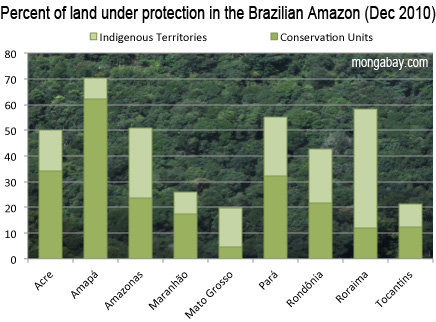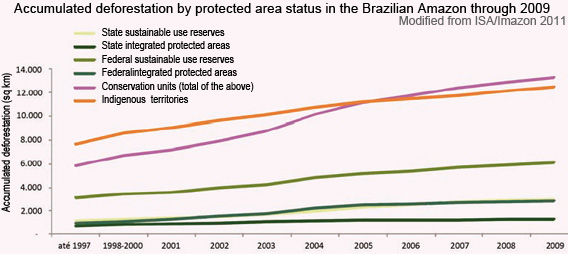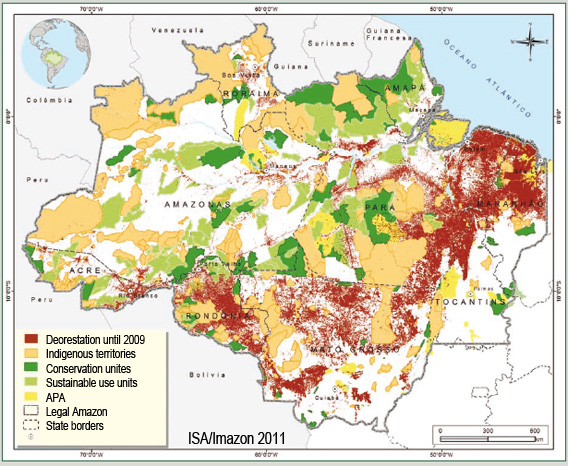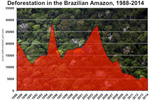Protected areas now cover nearly 44 percent of the Amazon — an area larger than Greenland — but suffer from encroachment and poor management, reports a new study by Imazon and the Instituto Socioambiental (ISA).
The report, published in Portuguese, says that by December 2010, protected areas in the Brazilian Amazon amounted to 2,197,485 square kilometers. Conservation units like national parks accounted for just over half the area (50.6 percent), while indigenous territories represented 49.4 percent.
 Percent of land under protection in the Brazilian Amazon as of December 2010 |
But while the extent of protected zones on paper is substantial, the report found significant human impacts in many areas. Between 1998 and 2009 12,204 square kilometers of forest within these areas was cleared. Damage was heaviest in designated “sustainable use” reserves.
The report faulted poor management as a contributing factor in degradation of protected areas. Half of protected areas in the Brazilian Amazon have no approved management plan and 45 percent has no management council. Staffing in some protected areas is very low — the state of Pará has only one officer per 1,817 square kilometers of forest.
 Accumulated deforestation by protected area status in the Brazilian Amazon through 2009 |
The report cites illegal logging and mining as threats to protected areas. It notes that 1,338 mining titles have been granted in protected areas, while 10,348 are awaiting approval.
The report comes as Brazil has been experiencing a decline in deforestation. Annual clearing is down more than 75 percent since 2004.
Brazil set aside more land in protected areas than any other country during the 2000s, accounting for nearly 60 percent of total terrestrial conservation during the decade. But research indicates that protected areas were responsible for only a portion of the reduction.

|
A 2010 study published in Proceedings of the National Academy of Sciences estimated that 37 percent of the recent decline in deforestation in the Brazilian Amazon can be attributed to newly established protected areas. Brazil designated some 709,000 square kilometers (274,000 sq mi) of Amazon forest — an area larger than the state of Texas — between 2002 and 2009 under its Amazon Protected Areas Program (ARPA).
Brazil has set ambitious deforestation reduction targets under its national climate change program.
CITATION: Veríssimo, A., Rolla, A., Vedoveto, M. & de Furtada, S.M. (2011) Áreas Protegidas na Amazônia Brasileira: avanços e desafios [PDF]. Imazon/ISA.
Related articles
Brazil’s Amazon deforestation rate falls to lowest on record

(12/01/2010) Deforestation in the Brazilian Amazon fell to the lowest rate on record, putting Brazil well on track to meet its targets for reducing rainforest destruction. Analysis of satellite imagery by Brazil’s National Institute for Space Research (INPE) shows that 6,450 square kilometers of rainforest were cleared in the Amazon in the 12 months ended July 31, 2010, a 14 percent drop from the year earlier period.
Brazil: king of conservation, deforestation for the 2000s

(12/21/2009) Brazil set aside more land in protected areas than any other country during the 2000s, accounting for nearly 60 percent of total terrestrial conservation during the decade, according to mongabay.com’s analysis of data from the U.N Environment Program and the World Conservation Monitoring Center. Paradoxically, Brazil also lost the most forest of any country during the decade.
Brazil’s plan to save the Amazon rainforest

(06/02/2009) Accounting for roughly half of tropical deforestation between 2000 and 2005, Brazil is the most important supply-side player when it comes to developing a climate framework that includes reducing emissions from deforestation and forest degradation (REDD). But Brazil’s position on REDD contrasts with proposals put forth by other tropical forest countries, including the Coalition for Rainforest Nations, a negotiating block of 15 countries. Instead of advocating a market-based approach to REDD, where credits generated from forest conservation would be traded between countries, Brazil is calling for a giant fund financed with donations from industrialized nations. Contributors would not be eligible for carbon credits that could be used to meet emission reduction obligations under a binding climate treaty.